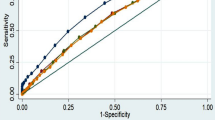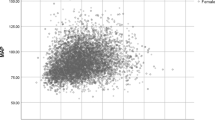Abstract
Objective: To determine optimal cutoff points of anthropometric measures as cardiovascular indicators in an Iranian adult population.
Design: Population-based cross-sectional study.
Setting: Tehran, the capital of Iran.
Subjects: A total of 10 522 subjects (4449 men and 6073 women) aged 18–74 y.
Methods: Demographic data were collected and anthropometric indices were measured. Blood pressure was evaluated and hypertension was defined based on JNC VI. Biochemical measurements were done. Diabetes was considered as FBS≥126 mg/dl (≥7.0 mmol/l) and dyslipidemia was defined according to ATP II. Risk factors were considered as: hypertension, diabetes, dyslipidemia, ‘hypertension or diabetes’, ‘hypertension and diabetes’, ‘hypertension or dyslipidemia’, ‘hypertension and dyslipidemia’, ‘ diabetes or dyslipidemia’, ‘diabetes and dyslipidemia’, ‘at least one risk factor’ and ‘at least two risk factors’. ROC curve analysis was performed to determine optimal cutoff values—where the sensitivity approximates specificity.
Results: Younger men (the age category of 18–34 y) had higher WC than women. Men had higher waist-to-hip ratio (WHpR) and lower waist-to-height ratio (WHtR) than women in all age categories. Dyslipidemia, ‘hypertension or dyslipidemia’, ‘diabetes or dyslipidemia’ and ‘at least one risk factor’ were more prevalent risk categories in both genders. Range of areas under ROC curves for BMI and WC was 0.55–0.94 and 0.56–0.93 for men and 0.41–0.94 and 0.53–0.92 for women in various age groups, respectively. Range of areas for WHpR and WHtR in men was between 0.58–0.87 and 0.56–0.94, respectively, and for women varied between 0.53–0.91 and 0.53–0.90 in various age groups, respectively. Cutoff points of BMI for various risk factors were between 24 and 29 kg/m2 in men and 25–31 kg/m2 in women. Range of WHpR was between 0.86 and 0.97 in men and between 0.78 and 0.92 in women. Cutoff points for WC and WHtR were between 80 and 93 cm and 0.47 and 0.56 for men and between 79 and 96 cm and 0.50 and 0.63 for women in different age groups to detect various risk factors, respectively. In general, values were lowest for the most prevalent risk factors and highest for less prevalent conditions.
Conclusion: The results suggested cutoff points of anthropometric measures as indicators of cardiovascular risk factors. It seems that these cut-points are higher for Iranians than for other Asian populations.
Sponsorship: Endocrine Research Center, Shaheed Beheshti University of Medical Sciences
This is a preview of subscription content, access via your institution
Access options
Subscribe to this journal
Receive 12 print issues and online access
$259.00 per year
only $21.58 per issue
Buy this article
- Purchase on Springer Link
- Instant access to full article PDF
Prices may be subject to local taxes which are calculated during checkout

Similar content being viewed by others
References
Azizi F, Allahverdian S, Mirmiran P, Rahmani M & Mohammadi F (2001): Dietary factors and body mass index in a group of Iranian adolescents: Tehran Lipid and Glucose Study. Int. J. Vitam. Nutr. Res. 71, 123–127.
Azizi F, Esmaillzadeh A & Mirmiran P (2004): Obesity in relation to cardiovascular disease risk factors: an epidemiologic study in Tehran. Iranian J. Endocrinol. Metab., in press.
Azizi F, Rahmani M, Emami H & Majid M (2000): Tehran Lipid and Glucose Study: rationale and design. C.V.D. Prev. 3, 242–247.
Ayatollahi SM & Carpenter RG (1993): Height, weight, BMI and weight-for-height of adults in southern Iran: how should obesity be defined? Ann. Hum. Biol. 20, 13–19.
Beegom R, Beegom R, Niaz MA & Singh RB (1995): Diet, central obesity and prevalence of hypertension in urban population of south India. Int. J. Cardiol. 51, 183–191.
Bray GA & Gray DS (1988): Treatment of obesity: an overview. Diabetes Metab. Rev. 4, 653–679.
Dary KP, Evans SL, Stevenson ET & Sales DR (1996): Adiposity and regional body fat distribution in physically active young and middle-aged women. Int. J. Obes. Relat. Metab. Disord. 20, 777–783.
Dipietro L, Katz LD & Nadel ER (1999): Excess abdominal adiposity remains correlated with altered lipid concentrations in healthy older women. Int. J. Obes. Relat. Metab. Disord. 23, 432–436.
Dobbelsteyn CJ, Joffres MR, MacLean DR, Flowerdew G & the Canadian Heart Health Surveys Research Group (2001): A comparative evaluation of waist circumference, waist-to-hip ratio and body mass index as indicators of cardiovascular risk factors: The Canadian Heart Health Surveys. Int. J. Obes. Relat. Metab. Disord. 25, 652–661.
Expert Committee on the Diagnosis and Classification of Diabetes Mellitus. (1997): Report of the Expert Committee on the Diagnosis and Classification of Diabetes Mellitus. Diab. Care 20, 1183.
Folsom AR, Kaye SA, Sellers TA, Hong CP, Cerhan JR, Potter JD & Prineas RJ (1993): Body fat distribution and 5-year risk of death in older women. JAMA 269, 483–487.
Gallagher D, Visser M, Sepulveda D, Pierson RN, Harris T & Heymsfield SB (1996): How useful is body mass index for comparison of body fatness across age, sex and ethnic groups. Am. J. Epidemiol. 143, 228–239.
Higgins M, Kannel W, Garrison R, Pinsky J & Stokes J (1988): Hazards of obesity—the Framingham experience. Acta. Med. Scand. 723, S23–S36.
Hsieh SD, Yoshinaga H (1995): Abdominal fat distribution and coronary heart disease risk factors in men-waist/height ratio as a simple and useful predictor. Int. J. Obes. Relat. Metab. Disord. 19, 585–589.
Ito H, Nakasuga K, Ohshima A, Maruyama T, Kaji Y, Harada M, Fukunaga M, Jingo S and Sakamoto M (2003): Detection of cardiovascular risk factors by indices of obesity obtained from anthropometry and dual-energy X-ray absorptiometry in Japanese individuals. Int. J. Obes. Relat. Metab. Disord. 27, 232–237.
Joint National Committee on Prevention, Detection, Evaluation and Treatment of High Blood Pressure. (1997): Sixth report of the Joint National Committee on prevention, detection, evaluation and treatment of high blood pressure. Arch. Intern. Med. 157, 2413–2446.
Lapidus L, Bengstsson C, Larsson B, Penerrt K, Rybo E & Sjostrom L (1984): Distribution of adipose tissue and risk of cardiovascular disease and death: a 12-year follow up of participants in the population study of women in Gothenburg, Sweden. Br. Med. J. 289, 1257–1261.
Ledoux M, Lambert J, Reeder BA & Despres JP (1997): A comparative analysis of weight to height and waist to hip circumference indices as indicators of the presence of cardiovascular disease risk factors. Canadian Heart Health Surveys Research Group. Can. Med. Assoc. J. 157 (Suppl 1), S32–S38.
Lemieux S, Prud'homme D, Bouchard C, Tremblay A & Despres JP (1996): A single threshold value of waist girth identifies normal-weight and overweight subjects with excess visceral adipose tissue. Am. J. Clin. Nutr. 64, 685–693.
Molarius A & Seidell JC (1998): Selection of anthropometric indicators for classification of abdominal fatness—a critical review. Int. J. Obes. Relat. Metab. Disord. 22, 719–727.
Must A, Spadano J, Coakley EH, Field AE, Colditz G & Dietz WH (1999): The disease burden associated with overweight and obesity. JAMA 282, 1523–1529.
National Cholesterol Education Program Expert Panel. (1993): Summary of the second report of the National Cholesterol Education Program Expert Panel on detection, evaluation and treatment of high blood cholesterol in adults. JAMA 269, 3015–3023.
Okosun IS, Liao Y, Rotimi CN, Choi S & Cooper RS (2000): Predictive values of waist circumference for dyslipidemia, type 2 diabetes and hypertension in overweight white, black and Hispanic American adults. J. Clin. Epidemiol. 53, 401–408.
Pishdad GR (1996): Overweight and obesity in adults aged 20–74 in southern Iran. Int. J. Obes. Relat. Metab. Disord. 20, 963–965.
Pi-Sunyer FX (1993): Medical hazards of obesity. Ann. Intern. Med. 119, 655–660.
Pi-Sunyer FX (2000): Obesity: criteria and classification. Proc. Nutr. Soc. 59, 505–509.
Pouliot MC, Despres JP, Lemieux S, Moorjani S, Bouchard C, Tremblay A, Nadeau A & Lupien PJ (1994): Waist circumference and abdominal sagittal diameter: best simple anthropometric indexes of abdominal visceral adipose tissue accumulation and related cardiovascular risk in men and women. Am. J. Cardiol. 73, 460–468.
Sarraf-Zadegan N, Boshtam M, Malekafzali H, Bashardoost N, Sayed-Tabatabaei FA, Rafiei M, Khalili A, Mostafavi S, Khami M & Hassanvand R (1999a): Secular trends in cardiovascular mortality in Iran, with special reference to Isfahan. Acta. Cardiol. 54, 327–333.
Sarraf-Zadegan N, Sayed-Tabatabaei FA, Bashardoost N, Mleki A, Totonchi M, Habibi HR, Sotodehmaram E, Tafazoli F & Karimi A (1999b): The prevalence of coronary artery disease in an urban population in Isfahan, Iran. Acta. Cardiol. 54, 257–263.
Seidell J, Han T, Feskens E & Lean M (1997): Narrow hips and broad waist circumferences independently contribute to increased risk of non-insulin-dependent diabetes mellitus. J. Intern. Med. 242, 401–406.
Seidell JC, Cigolini M, Charzewska J, Ellsinger BM & di-Biase G (1990): Fat distribution in European women: a comparison of anthropometric measurements in relation to cardiovascular risk factors. Int. J. Epidemiol. 19, 303–308.
Stevens J, Cai J, Pamuk ER, Williamson DF, Thun MJ & Wood JL (1998): The effect of age on the association between body mass index and mortality. N. Engl. J. Med. 338, 1–7.
Wei M, Gaskill SP, Haffner SM & Stern MP (1997): Waist circumference as the best predictor of non-insulin-dependent diabetes mellitus compared to BMI, WHR over other anthropometric measurements in Mexican Americans: a 7-year prospective study. Obes. Res. 5, 16–23.
World Health Organization. (1997a): Obesity epidemic puts millions at risk from related diseases, Press Release WHO/46 (online), June 12;: www.who.int/inf-prp1997/en/pr97-46.html.
World Health Organization. (1997b): Obesity: preventing and managing the global epidemic, Report of WHO consultation on obesity, 3–5 June; WHO/NUT/NCD/98.1. Geneva: WHO.
World Health Organization. (2000): The Asia-Pacific Perspective: Redefining Obesity. Geneva: World Health Organization.
Author information
Authors and Affiliations
Contributions
Guarantor: F Azizi.
Contributors: FA supervised the research and corrected the manuscript. PM and AE designed the study, collected and analyzed the data and wrote the manuscript.
Corresponding author
Rights and permissions
About this article
Cite this article
Mirmiran, P., Esmaillzadeh, A. & Azizi, F. Detection of cardiovascular risk factors by anthropometric measures in Tehranian adults: receiver operating characteristic (ROC) curve analysis. Eur J Clin Nutr 58, 1110–1118 (2004). https://doi.org/10.1038/sj.ejcn.1601936
Received:
Revised:
Accepted:
Published:
Issue Date:
DOI: https://doi.org/10.1038/sj.ejcn.1601936
Keywords
This article is cited by
-
Detection of high risk people for diabetes by American diabetes association risk score in PERSIAN Guilan cohort study
BMC Endocrine Disorders (2023)
-
Prevalence and determinants of dietary practices among pregnant women in eastern Ethiopia
BMC Nutrition (2022)
-
Prevalence of self-reported coronary heart disease and its associated risk factors in Tabari cohort population
BMC Cardiovascular Disorders (2020)
-
Correlation between overweightness and the extent of coronary atherosclerosis among the South Caspian population
BMC Cardiovascular Disorders (2020)
-
Association of proinflammatory genes expression with serum interleukin 1β and free fatty acids in metabolically healthy and unhealthy abdominally obese individuals: a case-control study
BMC Immunology (2019)



